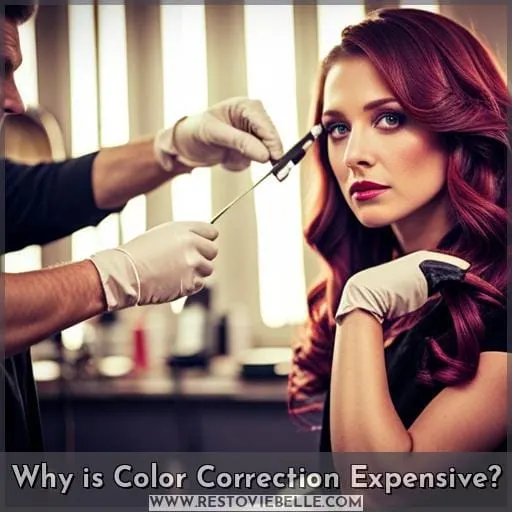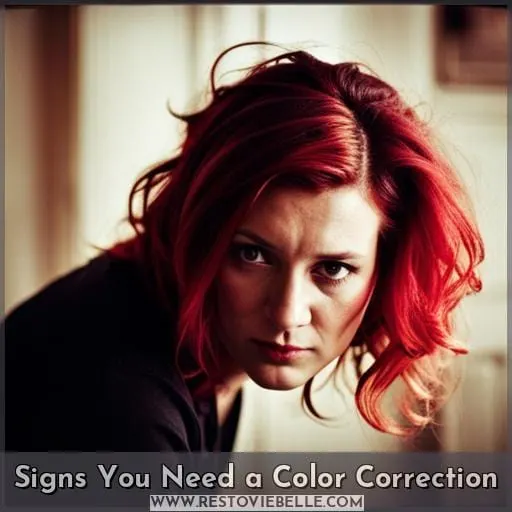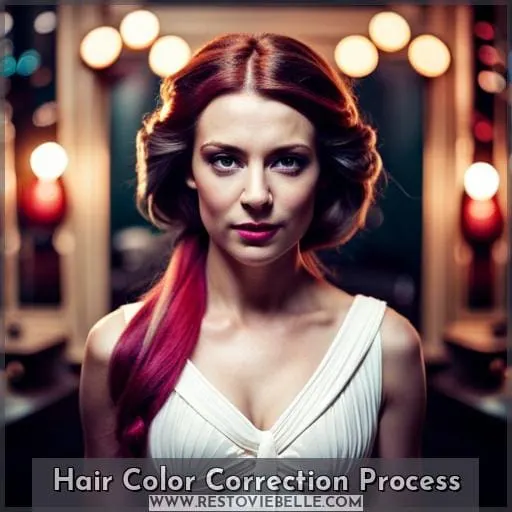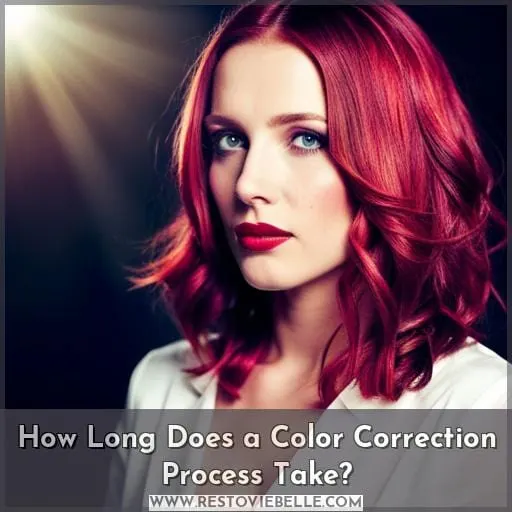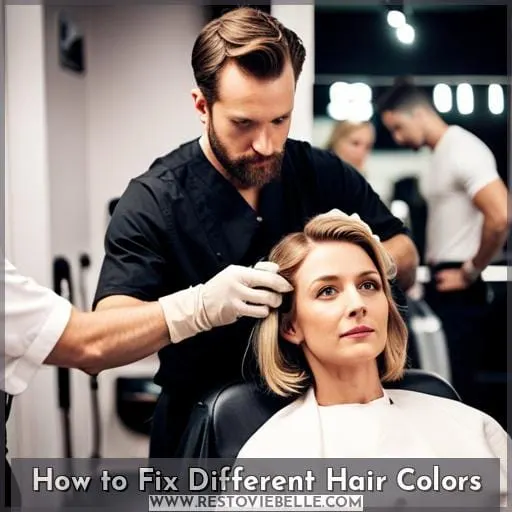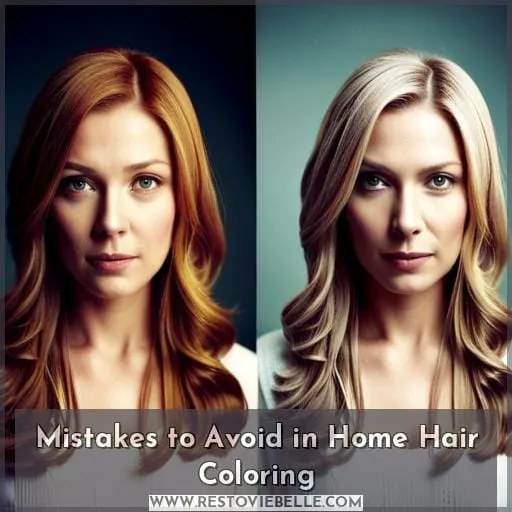This site is supported by our readers. We may earn a commission, at no cost to you, if you purchase through links.
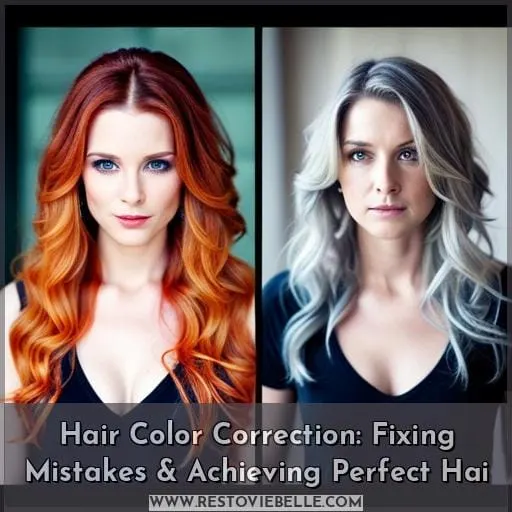 Don’t worry, we’ve all been there. You tried to color your hair at home or had a not-so-great salon experience, and now you’re left with a less-than-perfect hue. But fear not! Hair color correction is here to save the day and help you achieve that perfect hair you desire.
Don’t worry, we’ve all been there. You tried to color your hair at home or had a not-so-great salon experience, and now you’re left with a less-than-perfect hue. But fear not! Hair color correction is here to save the day and help you achieve that perfect hair you desire.
In this article, we’ll guide you through the process of fixing mistakes and give you expert tips on achieving flawless results.
Table Of Contents
- Key Takeaways
- Why is Color Correction Expensive?
- Signs You Need a Color Correction
- Hair Color Correction Process
- How Long Does a Color Correction Process Take?
- How to Fix Different Hair Colors
- Mistakes to Avoid in Home Hair Coloring
- Frequently Asked Questions (FAQs)
- Are there any non-chemical alternatives for color correction?
- Can color correction be done on all hair types and textures?
- Is it possible to achieve drastic color changes in one session of color correction?
- How often should I schedule touch-up appointments after a color correction?
- Are there any temporary solutions for color correction, such as color-correcting hair sprays or powders?
- Conclusion
Key Takeaways
- Hair color correction can be expensive due to the time-consuming process and the need for professional consultation.
- Factors contributing to the cost include the use of high-quality products and the often necessary multiple sessions.
- Signs that indicate the need for a color correction include uneven color, brassy tones, fading color, and hair color mishaps.
- The hair color correction process involves assessing the issue, selecting the right lightening products, rinsing and neutralizing, and applying the final color evenly.
Why is Color Correction Expensive?
Color correction can be expensive due to various factors that contribute to the overall cost of the process.
One of these factors is the time involved in performing a color correction. The process can be lengthy, often taking several hours or even multiple sessions to achieve the desired result. This not only requires a significant investment of time from both you and your stylist but also impacts their schedule and income potential.
Additionally, professional consultation plays a crucial role in determining the cost of color correction. A skilled stylist will assess your hair condition, evaluate any previous coloring history, and discuss your desired outcome before recommending appropriate products and techniques for achieving it.
Moreover, product recommendations play an important role in ensuring successful color correction results while minimizing damage to your hair. High-quality products may come at a higher price point but are essential for maintaining healthy hair during this transformative process.
Finally, aftercare tips provided by professionals are invaluable when it comes to preserving and prolonging the life of your corrected hair color. These tips include using specific shampoos and conditioners designed for colored hair as well as regular treatments like deep conditioning masks or salon services.
In conclusion, color corrections can be expensive due to factors such as prolonged appointments requiring multiple sessions, hair consultations with experienced stylists, recommended high-quality products, and necessary aftercare procedures.
However, the investment is worthwhile because it ensures expert guidance, tailored solutions, and long-lasting results.
Signs You Need a Color Correction
If you notice that your hair color doesn’t quite match your desired shade or isn’t flattering with your skin tone, it may be a sign that you need a color correction.
- Uneven Color: If you have patches of different shades throughout your hair, it’s likely an indication of uneven coloring.
- Brassy Tones: When blonde or brunette hair starts to turn brassy or reddish, it means the underlying pigments are showing through and need correction.
- Fading Color: If your vibrant color has faded quickly and looks dull, it might be time for a touch-up.
- Bad Balayage: A poorly done balayage can result in harsh lines and unnatural-looking highlights that require professional correction techniques.
- Hair Color Mishap: Whether you attempted at-home coloring yourself or had an inexperienced stylist handle the process, any major mishaps should prompt immediate attention from professionals.
Consulting with a hairstylist who specializes in color corrections is crucial for achieving beautiful results. They’ll provide expert advice on toning techniques, balayage corrections,and other appropriate methods based on their assessment of the signs mentioned above.
Hair Color Correction Process
Now, let’s delve into the hair color correction process to understand how professionals fix these mistakes.
The process involves several key steps:
- Assessing the hair color issue
- Selecting the right lightening products
- Rinsing and neutralizing the hair
- Applying the final color evenly
- Preventing future color issues through education and proper aftercare
Each step is crucial in achieving a harmonious and balanced shade while minimizing damage to your hair.
Assessing the Hair Color Issue
Evaluate your at-home hair color problem to determine the extent of the issue.
Assess any color imbalances, unwanted warm tones, or brassy streaks that may be present.
Consider your desired hair color and take into account the current health of your hair.
This assessment will help you understand what steps need to be taken during the hair color correction process.
Precise timing and careful evaluation are crucial for achieving optimal results in correcting your hair color mishaps while ensuring healthy-looking locks.
Selecting the Right Lightening Products
Choose the appropriate lightening product based on your starting hair color.
Consider these factors when selecting hair lightening products for optimal results in the color correction process:
- Take into account developer consideration to regulate lightening intensity.
- Ensure precise timing for each product to achieve the desired level.
- Contemplate using a toner service or purple shampoo during and after lightening.
- The neutralizing process is crucial for balancing unwanted tones before proceeding with further steps.
Rinsing and Neutralizing
Now that you have assessed the hair color issue and selected the right lightening products, it’s time to ensure optimal results during the hair color correction process.
Thoroughly rinse the hair after lightening.
Use a product like Blondor Seal & Care to neutralize any undesired tones.
Proper rinsing techniques and effective neutralization are crucial for achieving balanced, beautiful hair restoration.
| Rinsing Techniques | Neutralizing Process | Color Balancing |
|---|---|---|
| Thoroughly rinse after lightening. | Use Blondor Seal & Care for neutralization. | Balance colors for harmonious results. |
Final Color Application
Apply the final color mixture evenly to your hair for a harmonious and balanced shade.
Achieve optimal results by following these steps during the final color application in the hair color correction process:
- Formulate a specific color mixture based on desired result.
- Apply the color evenly, ensuring even coverage.
- Smooth the mixture over damp locks for consistent saturation.
By meticulously applying the final color, you can achieve beautiful and flawless results that complement your skin tone and ensure client satisfaction with their blonde hair transformation after fixing any previous mistakes during this crucial step of hair color correction process using toner or other appropriate products.
Preventing Future Color Issues
To prevent future color issues, educate yourself on proper hair care and maintenance.
Seek professional advice from a hairstylist during a consultation to understand your specific needs.
Avoid DIY risks by entrusting complex color corrections to professionals who’ve experience with the hair toners and products necessary for maintaining vibrant colors.
Use moisturizing products and follow post-treatment care instructions to keep your corrected hair healthy and hydrated.
Taking these precautions will help maintain the longevity of your desired hair color while avoiding future mishaps.
How Long Does a Color Correction Process Take?
The duration of a color correction process can vary depending on the severity of the issue and desired results. Factors such as hair type, texture, and porosity also play a role in determining the time required for correction.
Here are four key points to consider regarding the duration of a color correction process:
-
Severity of the Issue:
- The more extensive or complicated your hair color mistake is, the longer it may take to fix.
- Correcting major color mishaps may require multiple sessions spread out over weeks or even months.
- If your hair is damaged or weakened from previous coloring processes, extra care and time will be needed during each step of correcting your hair’s hue.
- Achieving perfect hair takes time and precision; if you’re aiming for drastic changes like going from dark brown to platinum blonde, expect longer processing times.
- A skilled stylist who specializes in color corrections can work efficiently while maintaining quality results within an appropriate timeframe.
How to Fix Different Hair Colors
When it comes to fixing different hair colors, there are several common issues that can arise.
- If you have a yellowish hue in your blonde hair, using a purple ash toner can help neutralize the unwanted yellow tones.
- For those dealing with brassy orange tones, opt for a blue-tinted shampoo or conditioner to counteract and restore balance.
- Ashy blondes looking for warmth can achieve this by using a red-toned toner along with developer.
- Lastly, if you have stripey highlights or dip-dye mistakes, blending or toning techniques can be employed to create an even and cohesive look overall while achieving color correction success.
Yellowish Hue
Neutralize the yellowish hue in your blonde hair by using a purple ash toner.
Purple toners work by canceling out the warm, brassy tones and leaving you with a cooler, more ashy blonde color.
Apply the toner according to the instructions provided and leave it on for the recommended amount of time.
This will help correct any unwanted brassiness and give your hair a beautiful, neutralized shade of blonde.
Remember to follow proper home coloring tips for best results!
Brassy Orange Tone
To fix your brassy orange tone, try using blue-tinted shampoo or conditioner.
Brassiness toning is a common issue in hair color correction, especially for those with dark hair colors.
Using clarifying shampoo and color-refreshing products can help neutralize the brassiness and restore a more balanced shade to your locks.
Don’t let hair mistakes hold you back from achieving the perfect hue!
Ashy Blonde
To fix ashy blonde hair, you can add warmth by using a red-toned toner along with a developer. This will help balance out the cool tones and bring more vibrancy to your blonde color.
Here are some haircare tips for ashy blondes:
- Consult with a stylist to determine the right toner shade.
- Use color-safe shampoo and conditioner to maintain color harmony.
- Avoid DIY dangers by seeking professional assistance for major corrections.
- Be mindful of potential hairline stains when applying toners at home.
- Take care of your hair texture through regular deep conditioning treatments.
Stripey Highlights
To soften stripey highlights, you can easily fix them by applying a base color close to your natural shade.
By using techniques like blending highlights and color balancing, you can correct the contrast between different hair colors and eliminate any visible stripes.
Additionally, incorporating products like Blondor Multiblonde Powder or blue tinted shampoo can aid in achieving a seamless result during the correction process.
Dip-Dye Mistakes
If you’ve made dip-dye mistakes in your hair color, there are ways to fix them and achieve a more even ombre look.
- Blending the dip-dye with the rest of your hair can help create a seamless transition.
- Fixing any roots that may have been missed during the coloring process is crucial for achieving a polished result.
- Understanding the color correction process and avoiding common mistakes will ensure successful results.
- Aftercare tips such as using color-safe products can also help maintain vibrant and long-lasting hair color.
Mistakes to Avoid in Home Hair Coloring
When it comes to home hair coloring, there are several common mistakes that you should avoid.
First, avoid washing your hair in the kitchen or bathroom sinks and opt for the shower instead to ensure thorough rinsing.
Secondly, carefully analyze the descriptions on hair dye boxes and consider your skin tone before selecting a shade.
Additionally, make sure to properly protect your skin and ears from staining by applying petroleum jelly and wearing old clothes during the coloring process.
Avoiding the Sink
When coloring your hair at home, it’s important to avoid washing your hair in the kitchen or bathroom sink.
- Avoid Staining: Hair dye can stain sinks and countertops, causing difficult-to-remove marks.
- Proper Rinsing: The shower provides better water pressure for thorough rinsing and removal of color.
- Skin Protection: Washing hair in the sink increases the risk of staining skin around the face and neck.
- Sink Dangers: Sinks may have sharp edges that could cause injuries while leaning over to wash hair.
By avoiding these sink-related mistakes, you can ensure a smoother home hair coloring experience without any unnecessary mishaps or accidents.
Analyzing the Description on the Box
Are you carefully analyzing the description on the box before attempting to color your hair at home?
Analyzing the details provided on the box is crucial for successful home hair coloring.
Pay attention to information about skin tone compatibility, as different shades may work better with warm or cool undertones.
Take note of any specific instructions regarding application and processing time.
Consider using hair swatches or consulting a professional for guidance in selecting the right shade and technique, such as blending or glazing.
Don’t overlook important details that can make a difference in achieving your desired result.
Coloring Beyond the Line
Avoid coloring beyond the line when doing hair color at home.
Coloring outside of the intended area can result in uneven and messy application.
To achieve seamless transitions and precision application, it’s important to stay within the lines.
Use blending techniques for root touch-ups or color corrections to ensure a natural-looking finish.
Practice good technique and take your time to avoid mistakes that may require additional color correction methods later on.
Choosing the Right Shade
To avoid color mishaps when coloring your hair at home, it’s essential to carefully choose the right shade that complements your skin tone.
- Consult color swatches or samples to determine compatibility with your skin tone.
- Seek expert advice from a professional stylist or colorist.
- Avoid DIY dye experiments and opt for professional help if unsure about the shade choice.
Proper Aftercare
To ensure the longevity and vibrancy of your newly colored hair, it’s essential to follow proper aftercare techniques.
After a color correction, your hair may be more prone to damage and dryness. To maintain its health and vibrancy, prioritize hydration by using hydrating shampoos and conditioners specifically designed for color-treated hair.
Additionally, incorporate deep conditioning treatments into your routine regularly to nourish and repair any damage caused during the coloring process.
Frequently Asked Questions (FAQs)
Are there any non-chemical alternatives for color correction?
Non-chemical alternatives for color correction are limited, but there are some options to consider.
These include using toning shampoos or conditioners to help neutralize unwanted tones, as well as natural remedies like lemon juice or chamomile tea rinses.
However, it’s important to note that these methods may not be as effective or long-lasting as professional treatments with specialized products and techniques.
For the best results and lasting color correction, consulting with a professional stylist is recommended.
Can color correction be done on all hair types and textures?
Color correction can be done on all hair types and textures.
The process requires expertise to assess the unique needs of each individual’s hair.
A skilled professional will tailor the correction techniques to achieve optimal results for your specific hair type and texture.
Is it possible to achieve drastic color changes in one session of color correction?
Achieving drastic color changes in one session of color correction is possible but depends on the starting hair color, condition, and desired result.
How often should I schedule touch-up appointments after a color correction?
After a color correction, touch-up appointments should be scheduled every 4-6 weeks to maintain the vibrancy and integrity of your hair. Consider it like tending to a flourishing garden, nurturing your newfound mastery over your mane.
Are there any temporary solutions for color correction, such as color-correcting hair sprays or powders?
Temporary solutions like color-correcting hair sprays or powders can be used to address minor color issues. These products help neutralize unwanted tones and provide a quick fix until a professional color correction can be done.
Conclusion
To achieve perfect hair color, hair color correction is often necessary. While it may seem expensive, the results are well worth it.
[Keypoints]Signs that you need a color correction include:
- A yellowish hue
- A brassy orange tone
- Ashy blonde
- Stripey highlights
- Dip-dye mistakes
The process involves:
- Assessing the issue
- Selecting the right products
- Rinsing and neutralizing
- Applying the final color
By avoiding common mistakes in home hair coloring and following proper aftercare, you can maintain your flawless color.
So embrace the transformation and achieve the perfect hair you desire!
